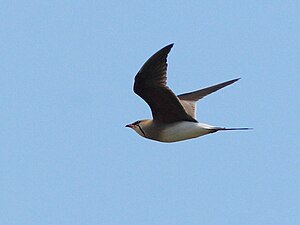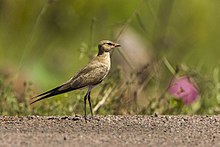Curlews
| Curlews | ||||||||
|---|---|---|---|---|---|---|---|---|

Red-winged curlew ( Glareola pratincola ) |
||||||||
| Systematics | ||||||||
|
||||||||
| Scientific name | ||||||||
| Glareolinae | ||||||||
| Brehm , 1831 |
The subfamily of the curlews ( Glareolinae ) belongs within the order of the plover-like in the family of the curlew-like . They have a distinctive flight pattern and live in wetlands , are migratory birds and occur in parts of Europe , Africa , Asia and Australia .
features
Curlew swallows have a body length between 17 cm (sandwheat swallow) and 26 cm (black-winged curlew). The name already reveals an external similarity to the swallows , which are not at all related , which is stronger than the similarities with the actually related racing birds . With the stilt curly swallow there is a species that mediates between racing birds and other curlew swallows. Brown or gray tones dominate in the plumage of the curlews.
The beak is short and curved. It is typically red at the base and black towards the end. Often it is a little lighter in the male than in the female, the only external sexual dimorphism , which nevertheless hardly serves to differentiate between the sexes. A gap remains when the beak is closed. The legs are shorter than those of the racing birds (exception: stilt swallow), but still long enough to enable them to run quickly on the ground. The foot is anisodactyl , so there is a rear toe, but it is very small and raised. The wings are long and pointed. The tail is usually forked; an exception is the stilt swallow, which like the racing birds has a rectangular tail.
In flight, curlews give very loud calls, reminiscent of the screams of terns . Large species sound more shrill than the smaller ones, whose calls appear more melodic.
distribution and habitat

The main distribution center of the curlews is in Africa and Asia. With the red-winged and black-winged curlew, two species have parts of their range on the European continent, the former in southern Europe, the latter in the extreme southeast. The deviant stilt swallow is the only species to breed on the Australian continent. Typical habitat are river landscapes in open terrain. The proximity of water is essential.
Many species are very long-distance migrants. The black-winged curlew breeds in the Eastern European steppes and migrates from here to Eastern and South Africa. The European red-winged curlew populations also overwinter south of the Sahara. The oriental curlew breeds in East Asia and migrates as far as Australia in winter, while the stilted curlew takes the opposite direction and migrates from Australia to Indonesia. The Madagascar Curlew only breed in Madagascar , but their entire population moves to East Africa after the breeding season. On the move, curlews cross unsuitable habitats such as deserts and rainforests at very high altitudes.
Way of life
Both during and outside the breeding season, curlews prefer to live in colonies and flocks. Especially in the past, these included a considerable number of individuals, so associations of black-winged curlew swallows in the southern Russian steppes could contain tens of thousands of individual animals. Members of a colony defend eggs and young together and attack birds of prey in association. Other birds often breed in the curlew colonies, for example the blackwing curlew with the lapwing and the curlew with terns and crocodile watchers . Outside the breeding season, curlews are often found socializing with other waterfowl, and different species such as the black and red-winged curlew mix in the flocks. All curlews are primarily crepuscular.
nutrition

With their wide beak, curlews nets insects from the air, and seldom they look for other invertebrates on the ground. The latter is particularly common in the deviant stilt swallow, which uses its wings to block the path of beetles and to capture them more easily. Curlews appear when swarms of large insects are on the move. So groups of curlews attack swarms of locusts, encircle them and prey on many of the insects. It also happens with swarming termites capable of flying. The red-winged curlew in Africa often follows the herds of large ungulates in order to prey on insects that they scare off. The collared curlew can be found on street lamps in African cities, where they hunt moths. In contrast to the related racing birds, curlews meet their fluid requirements through frequent drinking.
Reproduction
Curlews are colony breeders, the nests are usually a few meters apart. A small hollow on the floor serves as a nest, which is not laid out any further. One to four eggs are laid; clutch sizes are often smaller in the tropics than outside. This also applies to one and the same species: for example, populations of the red-winged curlew lay three eggs in Europe, but only one or two in Africa. Both parent birds breed alternately.
When in danger, parent birds often feign injuries and lure enemies away from the nest with outstretched wings. The young are also able to swim at the age of two days and, provided the nest is directly on the water, can jump into the water and swim away from an enemy.
Humans and curlews

In Hungary , eggs from colonies of the redwing curlew were previously collected until the populations there collapsed. In their European distribution areas, curlews are also threatened by the conversion of natural steppes into agricultural areas. Agricultural machines and large farm animals often destroy the clutch. In Africa and Australia, curlews are generally considered useful and welcome, as they follow swarms of locusts and greatly decimate them.
While six of the eight species are considered not to be endangered, the IUCN classifies the black-winged curlew as potentially endangered and the Madagascar curlew as endangered. Habitat loss is the cause of both.
Tribal history
Curlews have been known to be fossilized since the Miocene . Both the recent genus Glareola and the extinct genus Mioglareola were native to Europe during this period. It is assumed, however, that the group has an African origin. The red-winged curlew was still widespread in Central Europe during the Pleistocene .
Systematics
A distinction is made between two types. The seven typical curlews are placed in the genus Glareola . The distinctly different Australian stilt curlew, which mediates between curlews and racing birds , represents its own genus Stiltia :
-
Glareola
- Great Gray Swallow ( Glareola cinerea )
- Whistle Swallow ( Glareola lactea )
- Orient Brachschwalbe ( Glareola maldivarum )
- Black- winged curlew ( Glareola nordmanni )
- Collared Curlew ( Glareola nuchalis )
- Madagascar Swallow ( Glareola ocularis )
- Red-winged curlew ( Glareola pratincola )
-
Stiltia
- Stilts Brachschwalbe ( Stiltia Isabella )
literature
- Josep del Hoyo et al .: Handbook of the Birds of the World (HBW). Volume 3: Hoatzin to Auks. Lynx Edicions, Barcelona 1996, ISBN 84-87334-20-2 .
Individual evidence
- ↑ a b del Hoyo et al .: HBW Volume 3, Morphological Aspects , pp. 365-368, see literature
- ↑ del Hoyo et al .: HBW Volume 3, Voice , pp. 365-368, see literature
- ↑ del Hoyo et al .: HBW Volume 3, Habitat , pp. 368-369, see literature
- ↑ del Hoyo et al .: HBW Volume 3, Movements , pp. 372-373, see literature
- ↑ del Hoyo et al .: HBW Volume 3, General habits , pp. 369-370, see literature
- ↑ del Hoyo et al .: HBW Volume 3, Food and feeding , pp 370-371, see literature
- ↑ a b del Hoyo et al .: HBW Volume 3, Breeding , pp. 371-372, see literature
- ↑ del Hoyo et al .: HBW Volume 3, Relationship with man and Status and Conservation , pp. 373-375, see literature
- ↑ IUCN Red List of Threatened Species , accessed June 13, 2017.
- ↑ del Hoyo et al .: HBW Volume 3, Systematics , pp. 364-365, see literature
